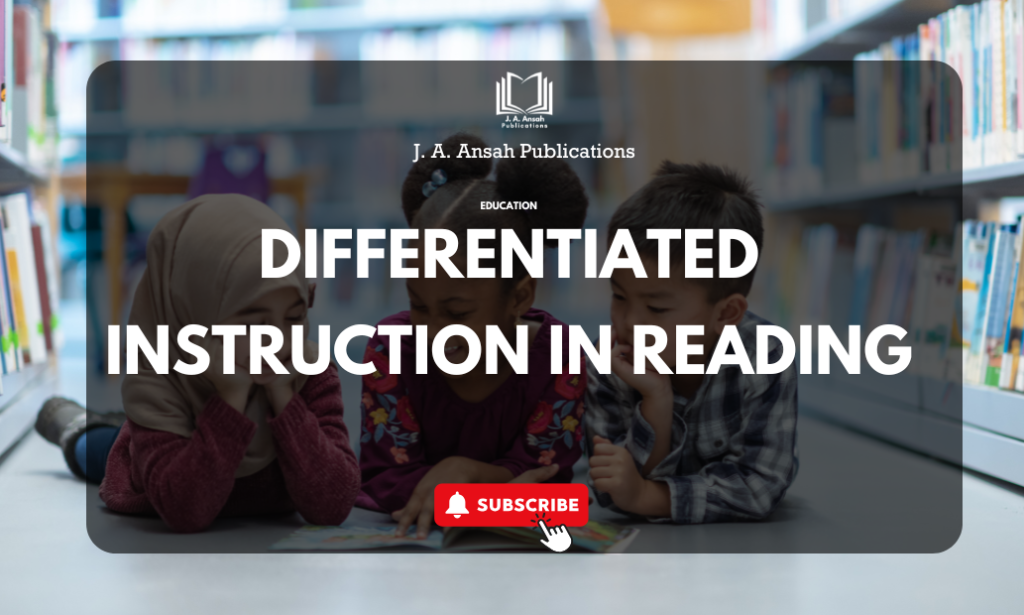DIFFERENTIATED INSTRUCTION IN READING
Differentiated instruction (DI) is a teaching approach that tailors instructional methods, materials and activities to meet the diverse needs of students. In reading, DI helps address the varying levels of ability, interests and learning profiles in a classroom, ensuring that all students can progress in their literacy skills (Tomlinson, 2014).
Key Principles of Differentiated Instruction
- Student-Centered Learning: Instruction is designed around the specific needs and abilities of each learner.
- Flexible Grouping: Students work in varying group configurations, including whole-class, small groups and pairs.
- Ongoing Assessment: Regular assessments guide instructional planning and ensure that each student is appropriately challenged.
- Variety of Instructional Strategies: Teachers use a mix of methods, such as direct instruction, guided practice, and independent work.
Importance in Reading Education
Differentiated instruction is critical in reading education due to the diverse levels of literacy development within a classroom. It helps to:
- Address skill gaps in struggling readers.
- Provide enrichment for advanced readers.
- Promote engagement by incorporating student interests.
Components of Differentiated Instruction in Reading
Content
- Definition: Content refers to the what of learning—the knowledge, skills and information students need to master.
- Strategies:
- Use leveled texts to ensure all students access material at their reading level.
- Incorporate multimedia resources (e.g., audiobooks, videos) to support diverse learning preferences.
- Provide vocabulary instruction tailored to student needs (Duke & Pearson, 2002).
Process
- Definition: Process involves how students make sense of the content.
- Strategies:
- Use graphic organisers to support comprehension.
- Differentiate guided reading sessions based on ability groups.
- Incorporate cooperative learning activities, such as literature circles.
Product
- Definition: Product refers to how students demonstrate their understanding.
- Strategies:
- Offer choices for final projects, such as written summaries, oral presentations, or creative projects.
- Use rubrics that account for varying skill levels.
- Implement portfolios to track growth over time.
Learning Environment
- Definition: The physical and emotional setting where learning takes place.
- Strategies:
- Create reading nooks for independent practice.
- Ensure classroom libraries include diverse genres and cultural representations.
- Foster a supportive atmosphere that encourages risk-taking.
Practical Applications of Differentiated Instruction in Reading
Planning Differentiated Lessons
- Pre-assessment: Use diagnostic tools to identify students’ current reading levels.
- Goal Setting: Develop specific, measurable, achievable, relevant and time-bound (SMART) goals for students.
- Instructional Design:
- Include a mix of whole-class instruction, small-group activities and independent work.
- Scaffold instruction to build foundational skills before advancing to complex tasks.
Strategies for Implementation
- Tiered Assignments: Design tasks with varying levels of complexity.
- Choice Boards: Allow students to select from a range of reading activities.
- Reading Workshops: Combine mini-lessons, independent reading and teacher-student conferences.
- Technology Integration: Use tools like e-books, reading apps and adaptive learning software to personalize instruction (Ciampa, 2012).
Addressing Challenges
- Time Constraints: Use station rotations to maximise instructional time.
- Classroom Management: Establish clear routines for group work and transitions.
- Teacher Preparation: Participate in professional development to learn effective DI strategies.
Assessing the Effectiveness of Differentiated Instruction
Formative Assessment
- Exit tickets, reading journals and informal observations.
- Use tools like running records to monitor fluency and comprehension.
Summative Assessment
- End-of-unit tests and cumulative projects.
- Analyse data to measure individual and group progress.
Feedback and Reflection
- Provide timely, constructive feedback to students.
- Reflect on instructional practices to identify areas for improvement.
Sources
Ciampa, K. (2012). Electronic storybooks: A constructivist approach to improving reading motivation in grade 1 students. Canadian Journal of Education, 35(4), 92-136.
Duke, N. K., & Pearson, P. D. (2002). Effective practices for developing reading comprehension. Journal of Education, 189(1), 107-122.
Tomlinson, C. A. (2014). The differentiated classroom: Responding to the needs of all learners (2nd ed.). Alexandria, VA: ASCD.



